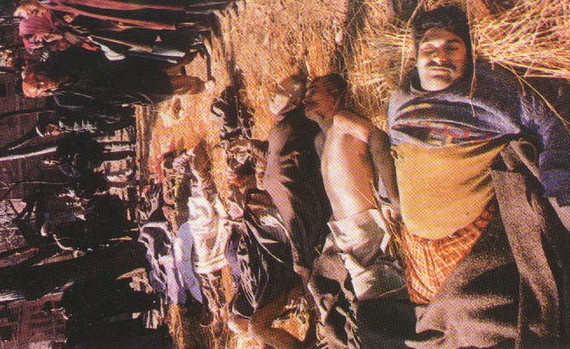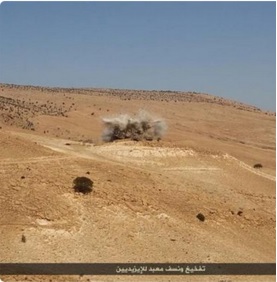Contribute
| How Genocide Brought Together Two Unlikely Communities: The Yazidi & The Hindus |
Pawan Deshpande
12/17/2014
In recent months, the plight of the Yazidi, an otherwise unknown people, has been brought to the center stage of world consciousness. Reports of mass executions of Yazidi males and boys, the sexual slavery of the surviving women and girls, forced conversions, the destruction of ancient shrines, the exile of hundreds of thousands has not only shocked many of us, but also garnered front-page attention in mainstream press, and, most notably, has galvanized support in the United States for military intervention in Iraq.
The ongoing ethnic cleansing in the sun-scorched mountains of Iraq conjures similar horrors from twenty-five years prior, thousands of miles away in the snowy valley of Kashmir in India. In September 1989, another Islamist militancy, this time fostered by Pakistan, took a heavy toll against the minority Hindu population of Kashmiri Pandits. Over the next year, a systematic campaign of executions, terror, rapes, and threats of violence caused approximately 400,000 Pandits to flee the region to refugee camps on a scale similar to that of the Yazidi today.
For the Pandits, return to their native land is near impossible now. The same will be true for the Yazidi, unless concrete steps are taken.
Keep the Women, Kill the Men
For both the Yazidi and Pandits, women and girls have often faced the worst conditions. A 14 year-old Yazidi girl tells of how she was kidnapped and forced to serve as a sex slave in a harem for ISIS militants. Other women have been forcibly converted to Islam, taken as slaves, and openly sold in markets, while others have served as human shields for ISIS fighters.
Many Pandits and Sikhs in Kashmir shared a parallel fate as the Yazidi shortly after the partition of India and Pakistan in October 1947. Aided by Pakistani army regulars, Islamist tribesmen descended into the Kashmir valley killing hundreds of Hindu and Sikh men, forcibly converted thousands while raping and taking the women as sex slaves back to Pakistan. During that year, some Hindu families went as far as keeping knives under their pillows at night, so they could end the lives of their wives and daughters in the event of an attack rather risking their enslavement.
More than forty years later in 1989, the remaining Pandits in Kashmir, by then consisting of less than five percent of the population, lived under the same continue threat as epitomized by the Islamist slogan "Assi gacchi panu'nuy Pakistan, batav rostuy, batenein saan." meaning "We are going to make our own Pakistan [Land of the Pure]. Without your men. But with your women."
The Killer Next Door
What's most troubling about both the purging of Yazidi and the Pandits from Iraq and Kashmir, respectively, is the condonement and, in many cases, willing participation in violence by members of the local Muslim majority population.
Dakhil Habash, a Yazidi who now resides in a refugee camp, told the New York Times, "Our Arab neighbors turned on all of us. We feel betrayed. They were our friends," referring to those who overnight started working with ISIS to hunt down remaining minorities in their town.
In Kashmir, the situation was no different. Rahul Pandita, a Hindu refugee from Kashmir, describes in his book, Our Moon Has Blood Clots: The Exodus of the Kashmiri Pandits, how many of his Muslim neighbors and family friends willingly partook in the slaughter and violence to usurp their property and possessions. In other cases, local hospitals largely administered by Muslims in Kashmir, would deny medical aid outright for Kashmiri Hindus, particularly those who had been wounded by militants. One Kashmiri Hindu elder recalled, "Our people were killed. I saw a girl tortured with cigarette butts. Another man had his eyes pulled out and his body hung on a tree... It wasn't just the killing but the way they tortured and killed."
Erasing their Past
In the past twenty five years, with the forced displacement of the native Hindu population, a systematic campaign to erase the millennia old Hindu history of Kashmir. Many of their temples have been ransacked, or demolished under the cover of public works projects. Other historic Hindu landmarks have been Islamicized by government bodies. For example, the famous Shankarcharya Hill, originally named after revered Hindu theologian who visited it in the 9th century, was renamed as Takht-e-Suleiman or "Tomb of Solomon" by the state's tourism board. With no local Hindu populace present, there is little that can be done.
Similarly, the Yazidi are facing a similar erasure of their cultural and historical relics as shown in the tweet above. Even if the Yazidi's were able to return to their homes and lands, there is little left for them.
The Politics of Reconciliation
What's particularly thorny is that in both cases external Islamist influences have stoked much of the local Muslim populace into willingly engaging in the ethnic cleansing of an unarmed and vulnerable minority. As a result, it's not easy to discriminate between violence committed by extremist militant and the locals.
In the case of Kashmir, there are now virtually no Hindus left in the region. Though decades have passed since the purging of Hindus, there have been few prosecutions of members of the local population responsible for the violence. The Kashmiri Hindus languish in refugee camps, while their neighbors have usurped their abandoned homes. In fact, in a futile attempt by the Indian government to quell the Islamist insurgency through political concessions, many of those behind the militancy have since been elevated to credible positions in political parties.
For the Yazidi people, the future may look the same. In a few years, at the current rate of cleansing, the entire Yazidi population may be relegated to refugee camps outside of Iraq. Similarly, in the event that ISIS is degraded, in order to make political reconciliations between the Shia-led Iraqi state and the Sunni insurgents, many of those responsible for the violence against the Yazidi may be granted positions of power in the resulting government -- effectively granting impunity for these crimes.
A Common Cause
In the past few months, the Yazidi and Hindu communities from across America have come together bound by similarities in their ancient faiths and shared struggles with Islamism. Last month, the two communities held a joint protest in front of the White House demanding that more be done to stop ISIS and end the Yazidi genocide.
Jay Kansara, the Associate Director of Government Relations of the Hindu American Foundation wrote about his experience:
Baba Sheikh, the highest Yazidi spiritual authority, is currently meeting with literally anyone who will give him and his followers time. You can see the tears in his eyes for his people who face extinction. I attended their protest in front of the White House, where I met a number of the community members. Many travelled from across the country for days to ensure their voices were heard by President Obama. It was a heart wrenching experience to see both men and women crying for their unimaginable loss.
Hindu organizations such as SEWA International and Art of Living, along with Hindus around the world have opened their hearts to the Yazidis by joining their advocacy efforts. We'll continue our multi-pronged efforts on their behalf.
Unlike the tragedy that has befallen the Kashmiri Hindus twenty five years ago, the survival of the extant Yazidi people is present and can be stopped. Let's not let history repeat itself.
You may also access this article through our web-site http://www.lokvani.com/


